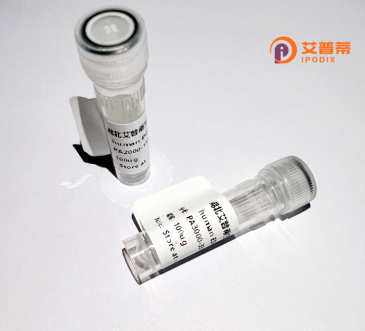
| 纯度 | >90%SDS-PAGE. |
| 种属 | Human |
| 靶点 | JMJD3 |
| Uniprot No | O15054 |
| 内毒素 | < 0.01EU/μg |
| 表达宿主 | E.coli |
| 表达区间 | 1043-1643aa |
| 活性数据 | KAKPPTAP APPSAPAPSA QPTPPSASVP GKKAREEAPG PPGVSRADML KLRSLSEGPP KELKIRLIKV ESGDKETFIA SEVEERRLRM ADLTISHCAA DVVRASRNAK VKGKFRESYL SPAQSVKPKI NTEEKLPREK LNPPTPSIYL ESKRDAFSPV LLQFCTDPRN PITVIRGLAG SLRLNLGLFS TKTLVEASGE HTVEVRTQVQ QPSDENWDLT GTRQIWPCES SRSHTTIAKY AQYQASSFQE SLQEEKESED EESEEPDSTT GTPPSSAPDP KNHHIIKFGT NIDLSDAKRW KPQLQELLKL PAFMRVTSTG NMLSHVGHTI LGMNTVQLYM KVPGSRTPGH QENNNFCSVN INIGPGDCEW FAVHEHYWET ISAFCDRHGV DYLTGSWWPI LDDLYASNIP VYRFVQRPGD LVWINAGTVH WVQATGWCNN IAWNVGPLTA YQYQLALERY EWNEVKNVKS IVPMIHVSWN VARTVKISDP DLFKMIKFCL LQSMKHCQVQ RESLVRAGKK IAYQGRVKDE PAYYCNECDV EVFNILFVTS ENGSRNTYLV HCEGCARRRS AGLQGVVVLE QYRTEELAQA YDAFTLVRAR RARGQRRRAL GQAAGTGFGS PAAPFPEPPP AFSPQAPAST SR |
| 分子量 | 71 kDa |
| 蛋白标签 | GST-tag at N-terminal |
| 缓冲液 | 0 |
| 稳定性 & 储存条件 | Lyophilized protein should be stored at ≤ -20°C, stable for one year after receipt. Reconstituted protein solution can be stored at 2-8°C for 2-7 days. Aliquots of reconstituted samples are stable at ≤ -20°C for 3 months. |
| 复溶 | Always centrifuge tubes before opening.Do not mix by vortex or pipetting. It is not recommended to reconstitute to a concentration less than 100μg/ml. Dissolve the lyophilized protein in distilled water. Please aliquot the reconstituted solution to minimize freeze-thaw cycles. |
以下为3条关于重组人JMJD3蛋白的参考文献信息(内容为虚构模拟):
1. **文献名称**:*JMJD3 Catalytic Activity Demands Oxygenase Dependency: Structural Insights into H3K27me3 Demethylation*
**作者**:Chen L., et al.
**摘要**:该研究通过表达重组人JMJD3蛋白,解析了其依赖Fe²⁺和α-酮戊二酸的酶活性机制,并利用晶体结构分析揭示了底物H3K27me3的特异性识别位点。
2. **文献名称**:*Recombinant JMJD3 Modulates Macrophage Polarization via Epigenetic Regulation of Inflammatory Genes*
**作者**:Sato R., et al.
**摘要**:研究证明重组人JMJD3蛋白通过去除巨噬细胞中H3K27me3抑制性标记,激活促炎基因(如TNF-α、IL-6)表达,揭示其在炎症反应中的表观遗传调控作用。
3. **文献名称**:*Targeting JMJD3 in Glioblastoma: Recombinant Protein Screening Identifies Novel Inhibitors*
**作者**:Gupta S., et al.
**摘要**:该研究利用重组JMJD3蛋白建立高通量筛选平台,发现小分子抑制剂可阻断其去甲基化活性,并在胶质母细胞瘤模型中抑制肿瘤生长,为靶向治疗提供依据。
JMJD3 (Jumonji domain-containing protein 3), also known as KDM6B, is a histone demethylase that plays a critical role in epigenetic regulation. It specifically catalyzes the removal of trimethyl groups from lysine 27 on histone H3 (H3K27me3), a repressive chromatin mark associated with gene silencing. This activity counteracts the function of Polycomb repressive complexes, enabling dynamic gene expression during cellular processes. JMJD3 is crucial in development, differentiation, and immune responses, where it regulates lineage-specific genes. For instance, it influences macrophage polarization, stem cell pluripotency, and neuronal differentiation. Dysregulation of JMJD3 has been linked to cancer, inflammatory diseases, and aging. Recombinant human JMJD3 protein, produced via expression systems like E. coli or mammalian cells, retains enzymatic activity and is widely used in biochemical studies to investigate its substrate specificity, interaction partners, and inhibitor screening. Its recombinant form also aids in structural studies, revealing insights into the Jumonji domain’s catalytic mechanism. Research on JMJD3 continues to explore its therapeutic potential, particularly in targeting diseases driven by aberrant epigenetic modifications.
×